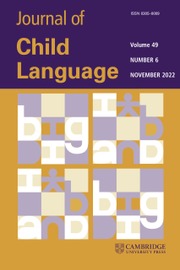Adult reformulations of child errors as negative evidence
Published online by Cambridge University Press: 07 August 2003
Abstract
Parents frequently check up on what their children mean. They often do this by reformulating with a side sequence or an embedded correction what they think their children said. These reformulations effectively provide children with the conventional form for that meaning. Since the child's utterance and the adult reformulation differ while the intended meanings are the same, children infer that adults are offering a correction. In this way, reformulations identify the locus of any error, and hence the error itself. Analyses of longitudinal data from five children between 2;0 and 4;0 (three acquiring English and two acquiring French) show that (a) adults reformulate their children's erroneous utterances and do so significantly more often than they replay or repeat error-free utterances; (b) their rates of reformulation are similar across error-types (phonological, morphological, lexical, and syntactic) in both languages; (c) they reformulate significantly more often to younger children, who make more errors. Evidence that children attend to reformulations comes from four measures: (a) their explicit repeats of corrected elements in their next turn; (b) their acknowledgements (yeah or uh-huh) as a preface to their next turn; (c) repeats of any new information included in the reformulation; and (d) their explicit rejections of reformulations where the adult has misunderstood. Adult reformulations, then, offer children an important source of information about how to correct errors in the course of acquisition.
Information
- Type
- Research Article
- Information
- Copyright
- © 2003 Cambridge University Press
Footnotes
- 191
- Cited by

